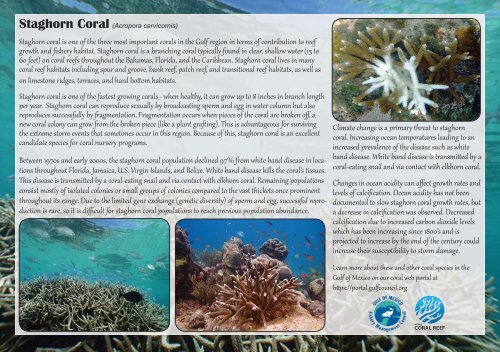ESA Corals From the Gulf of Mexico
Set of pamphlets which highlights basic information about Endangered Species Act (ESA) listed corals from the Gulf of Mexico
Set of pamphlets which highlights basic information about Endangered Species Act (ESA) listed corals from the Gulf of Mexico
Create successful ePaper yourself
Turn your PDF publications into a flip-book with our unique Google optimized e-Paper software.
Staghorn Coral (Acropora cervicornis)<br />
Staghor coral is one <strong>of</strong> <strong>the</strong> three most imporant corals in <strong>the</strong> <strong>Gulf</strong> region in ters <strong>of</strong> contibution to reef<br />
gowth and fisher habitat. Staghor coral is a branching coral tically found in clear, shallow water (15 to<br />
60 feet) on coral reefs throughout <strong>the</strong> Bahamas, Florida, and <strong>the</strong> Caribbean. Staghor coral lives in many<br />
coral reef habitats including spur and goove, bank reef, patch reef, and tansitional reef habitats, as well as<br />
on limestone ridges, teraces, and hard boom habitats.<br />
Staghor coral is one <strong>of</strong> <strong>the</strong> fastest gowing corals - when healthy, it can gow up to 8 inches in branch lengh<br />
per year. Staghor coral can reproduce sexally by broadcasting sper and egg in water column but also<br />
reproduces successflly by agentation. Fragentation occurs when pieces <strong>of</strong> <strong>the</strong> coral are broken <strong>of</strong>f, a<br />
new coral colony can gow om <strong>the</strong> broken piece (like a plant gaſting). This is advantageous for suriving<br />
<strong>the</strong> exeme stor events that sometimes occur in this region. Because <strong>of</strong> this, staghor coral is an excellent<br />
candidate species for coral nurser progams.<br />
Beteen 1970s and early 2000s, <strong>the</strong> staghor coral population declined 97% om white band disease in locations<br />
throughout Florida, Jamaica, U.S. Virgin Islands, and Belize. White band disease kills <strong>the</strong> coral’s tissues.<br />
This disease is tansmied by a coral-eating snail and via contact with elkhor coral. Remaining populations<br />
consist mostly <strong>of</strong> isolated colonies or small goups <strong>of</strong> colonies compared to <strong>the</strong> vast thickets once prominent<br />
throughout its range. Due to <strong>the</strong> limited gene exchange (genetic diversit) <strong>of</strong> sper and egg, successfl reproduction<br />
is rare, so it is difficult for staghor coral populations to reach previous population abundance.<br />
Climate change is a primar threat to staghor<br />
coral. Increasing ocean temperatres leading to an<br />
increased prevalence <strong>of</strong> <strong>the</strong> disease such as white<br />
band disease. White band disease is tansmied by a<br />
coral-eating snail and via contact with elkhor coral.<br />
Changes in ocean acidit can affect gowth rates and<br />
levels <strong>of</strong> calcification. Ocean acidit has not been<br />
documented to slow staghor coral gowth rates, but<br />
a decrease in calcification was obsered. Decreased<br />
calcification due to increased carbon dioxide levels<br />
which has been increasing since 1800’s and is<br />
projected to increase by <strong>the</strong> end <strong>of</strong> <strong>the</strong> centr could<br />
increase <strong>the</strong>ir susceptibilit to stor damage.<br />
Lear more about <strong>the</strong>se and o<strong>the</strong>r coral species in <strong>the</strong><br />
<strong>Gulf</strong> <strong>of</strong> <strong>Mexico</strong> on our coral web poral at<br />
hs://poral.glfcouncil.org


